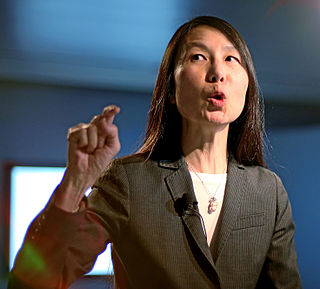
William Henry Gates III is an American business magnate, software developer, investor, author, and philanthropist. He is a co-founder of Microsoft, along with his late childhood friend Paul Allen. During his career at Microsoft, Gates held the positions of chairman, chief executive officer (CEO), president and chief software architect, while also being the largest individual shareholder until May 2014. He is considered one of the best known entrepreneurs of the microcomputer revolution of the 1970s and 1980s.
Software engineering is the systematic application of engineering approaches to the development of software.

The waterfall model is a breakdown of project activities into linear sequential phases, where each phase depends on the deliverables of the previous one and corresponds to a specialisation of tasks. The approach is typical for certain areas of engineering design. In software development, it tends to be among the less iterative and flexible approaches, as progress flows in largely one direction through the phases of conception, initiation, analysis, design, construction, testing, deployment and maintenance.

James Arthur Gosling, often referred to as "Dr. Java", OC is a Canadian computer scientist, best known as the founder and lead designer behind the Java programming language.

Xenix is a discontinued version of the Unix operating system for various microcomputer platforms, licensed by Microsoft from AT&T Corporation in the late 1970s. The Santa Cruz Operation (SCO) later acquired exclusive rights to the software, and eventually replaced it with SCO UNIX.
Cargo cult programming is a style of computer programming characterized by the ritual inclusion of code or program structures that serve no real purpose. Cargo cult programming is symptomatic of a programmer not understanding either a bug they were attempting to solve or the apparent solution. The term cargo cult programmer may apply when anyone inexperienced with the problem at hand copies some program code from one place to another with little understanding of how it works or whether it is required.
The Open Letter to Hobbyists is a 1976 open letter written by Bill Gates, the co-founder of Microsoft, to early personal computer hobbyists, in which Gates expresses dismay at the rampant software piracy taking place in the hobbyist community, particularly with regard to his company's software.
Code review is a software quality assurance activity in which one or several people check a program mainly by viewing and reading parts of its source code, and they do so after implementation or as an interruption of implementation. At least one of the persons must not be the code's author. The persons performing the checking, excluding the author, are called "reviewers".
Micro Instrumentation and Telemetry Systems (MITS) was an American electronics company founded in Albuquerque, New Mexico that began manufacturing electronic calculators in 1971 and personal computers in 1975.

Charles Simonyi is a Hungarian-born American software architect. He started and led Microsoft's applications group, where he built the first versions of Microsoft Office software suite.
A software requirements specification (SRS) is a description of a software system to be developed. It is modeled after business requirements specification(CONOPS), also known as a stakeholder requirements specification (StRS). The software requirements specification lays out functional and non-functional requirements, and it may include a set of use cases that describe user interactions that the software must provide to the user for perfect interaction.
In the context of software engineering, software quality refers to two related but distinct notions:
The Software Peter principle is used in software engineering to describe a dying project which has become too complex to be understood even by its own developers.

Richard Farris Rashid is the founder of Microsoft Research, which he created in 1991. Between 1991 and 2013, as its chief research officer and director, he oversaw the worldwide operations for Microsoft Research which grew to encompass more than 850 researchers and a dozen labs around the world.
Coding best practices are a set of informal rules that the software development community employs to help improve software quality.
Douglas Taylor "Doug" Ross was an American computer scientist pioneer, and chairman of SofTech, Inc. He is most famous for originating the term CAD for computer-aided design, and is considered to be the father of Automatically Programmed Tools (APT), a programming language to drive numerical control in manufacturing. His later work focused on a pseudophilosophy he developed and named Plex.

Jeannette Marie Wing is Avanessians Director of the Data Science Institute at Columbia University, where she is also a professor of computer science. Until June 30, 2017, she was Corporate Vice President of Microsoft Research with oversight of its core research laboratories around the world and Microsoft Research Connections. Prior to 2013, she was the President's Professor of Computer Science at Carnegie Mellon University, Pittsburgh, Pennsylvania, United States. She also served as assistant director for Computer and Information Science and Engineering at the NSF from 2007 to 2010. She was appointed the Columbia University executive vice president for research in 2021.
Proprietary software, also known as non-free software or closed-source software, is computer software for which the software's publisher or another person reserves some rights from licenses to use, modify, share modifications, or share the software. It is the opposite of open-source or free software. Non-free software sometimes includes patent rights.

Margaret Heafield Hamilton is an American computer scientist, systems engineer, and business owner. She was director of the Software Engineering Division of the MIT Instrumentation Laboratory, which developed on-board flight software for NASA's Apollo program. She later founded two software companies—Higher Order Software in 1976 and Hamilton Technologies in 1986, both in Cambridge, Massachusetts.
Software construction is a software engineering discipline. It is the detailed creation of working meaningful software through a combination of coding, verification, unit testing, integration testing, and debugging. It is linked to all the other software engineering disciplines, most strongly to software design and software testing.







